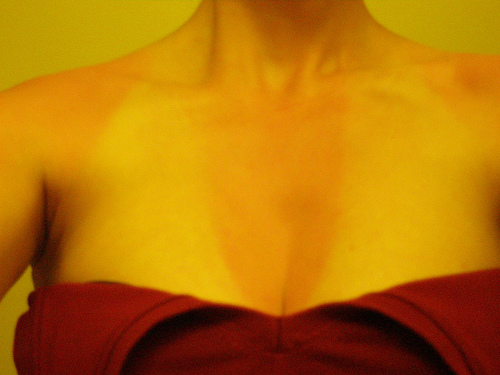For those of us trapped in the 8-to-5 grind, there is nothing more luxurious than sleeping in on Saturday morning and awakening to the twittering birds and the clear sunlight filtering through the window. Pure bliss, right?For me, the bliss doesn’t last long. The mere mention of a sun-drenched room fills me with fear of ultraviolet exposure. Ultraviolet, my sworn enemy, harbinger of skin cancer and the dreaded signs of aging. Keep thy precancerous lesions and wrinkles away from me, thou devil dressed in light!As a teen, I didn’t worry too much about sun exposure. But with college came nursing school, and with nursing school came bed baths. Lots of bed baths. At first I groaned at this task but quickly discovered how much I could learn about a human body from bathing one. For instance, I witnessed the differences between a lifetime of exercise and a lifetime of television. I was struck by the drastic differences between the sun-exposed areas on the body and the areas that remain beneath clothes throughout the decades. The spotted, corrugated skin on a typical octogenarian’s face and hands contrasted starkly with the skin on places like the belly and buttocks. The hidden bits were usually as unblemished and taut as they would be in someone three or four decades younger. I began slathering sunscreen onto myself with religious fervor. Since that time, my anti-solar antics have grown exponentially. Even I think I’m a little nuts. Case in point: I’ve taken to applying sunscreen at night, in order to protect myself from those spring sunbeams pouring through my bedroom window each morning. I started doing this after suffering prolonged chest pain and nausea when I learned that window glass does not filter out the sun’s damaging UVA rays. UVA accounts for 95 percent of the ultraviolet radiation that reaches the surface of our planet, while the remaining 5 percent is UVB. UVB is adequately filtered by glass, but UVA is not. That’s why indoor furniture and paintings fade over time. Heliophobia is not my only neurosis, but it is the one most strongly rooted in science. The Skin Cancer Foundation notes that 90 percent of nonmelanoma skin cancers are related to sun exposure, while 65 percent of melanomas are associated with UV radiation. UVA (aging) and UVB (burning) rays damage the DNA of skin cells and proteins, such as collagen, that keep the skin firm. The Skin Cancer Foundation recommends daily broad-spectrum SPF 15 or higher sunscreen use as part of a comprehensive sun-protection plan, which should also include sun avoidance, protective clothing and abstinence from tanning. Finding an acceptable sunscreen has remained a thorn in my lily-white side for years. You see, not all sunscreens are created equally. Sunscreens differ in efficacy and drawbacks. In the media, meaningful analyses of the risks and benefits of sunscreen are virtually nonexistent. Instead, consumers often hear exaggerated accounts of sunscreen’s anti-aging, cancer-busting benefits. Likewise, consumers are bombarded with frightening accounts of the potential or unknown risks of sunscreens, such as the Environmental Working Group’s concern over an estrogen-like chemical called oxybenzone. Gee, it’s almost as if there should be some sort of agency that could monitor and evaluate the efficacy of sunscreen ingredients, disclose risks to the public, and regulate how these products are marketed to the public. Kind of like, you know, what the Food and Drug Administration should be doing. FDA sunscreen regulations date back to 1978, when bronzed skin was all the rage at the disco or whatever. The FDA has been trying to update these regulations since 1993. New regulations were finally unveiled in 2007. Predictably, the sunscreen and cosmetics industry made a big stink about the regulations, so a final rule was never adopted. Fast-forward to May 2010 when the FDA announced it was finally ready to enact even newer, better regulations. They said they’d make the new rules official around October 2010. Those of us following the story held our collective breath in anticipation. On Oct. 6, 2010, the Environmental Working Group sent a letter to the FDA urging the agency to finalize its regulations for sunscreen products. Yet the FDA remained mum. And now it’s April 2011, and those much-needed regulations are still out there in policy limbo. The proposed UVA protection rating system is the most crucial aspect of the newest FDA regulations. Sunscreens come with an SPF rating, which only pertains to UVB rays. The Skin Cancer Foundation has generated a consumer’s guide to sunscreens with high UVA protection. Similarly, the Environmental Working Group offers a list of sunscreens without controversial chemicals like retinyl palmitate. Yet the point here is that sunscreens are chemicals that alter the skin’s ultraviolet defenses, and, like any drug, sunscreens come with risks and benefits. A realistic discussion of sunscreen can’t happen until we know more about them. Because of this, the FDA should start regulating sunscreen formulations like drugs. Pharmaceutical companies are prohibited from marketing drugs for conditions they weren’t tested or approved for, and they (theoretically) can’t get away without disclosing the side effects and adverse reactions associated with that drug. Why shouldn’t this be the case for sunscreen?Until the FDA mans up, most experts still strongly recommend a daily sunscreen. Considering that the incidence of skin cancer has skyrocketed over the last century, the benefits of appropriately using a good sunscreen still outweigh the risks. I, for one, will keep coating my epidermis with titanium dioxide until I’m begging the poor young nurse giving me a bed bath to smear sunscreen on my exceptionally preserved pelt.
Despite its brilliant name, this column is not intended to prevent, diagnose or treat herpes. Or any other diseases, for that matter.Whitny Doyle is a family nurse practitioner grad student.The opinions expressed are solely those of the author. All sources available at alibi.com.






